Expert fitness coaches recommend these nine strength training exercises for weight loss
Swap some HIIT workouts and treadmill sessions for lifting weights to build strength and lose weight sustainably


People often overlook using strength training exercises for weight loss in favor of HIIT workouts or cardio-based exercises like running. But these people are missing a trick.
Strength training can increase your muscle mass, which will improve your metabolism. That's because muscle is a metabolically active tissue, which means that your body burns calories to maintain it. Build more muscle and you'll burn more calories, even when you're resting.
Fit&Well spoke to strength and conditioning coach Ryan Horton of Horton Barbell and F45 Paddington trainer Rachael Penrose to find out why you might consider swapping a treadmill for some dumbbells in your mission to lose weight—and which exercises they would recommend for beginners.

Rachel Penrose is a trainer at functional training gym F45 Paddington in the U.K. Born in Sydney, Australia, she began dance training at just three years old and went on to perform as a soloist in an all Australian female revue show while living in Las Vegas. Having always had a passion for wellbeing, she moved to London in 2017 and entered the world of fitness. Since then, she has accumulated a wide client base, fronted fitness events and programmed workouts for an array of exercise brands.

Ryan Horton is the owner of Horton Barbells. He has worked as a strength and conditioning coach and sports scientist for 20 years at schools like the University of Tennessee, Temple and Georgia Tech.
How to start strength training for weight loss
When learning how to use strength training to torch fat, it’s first important to understand the key principle behind weight loss: a calorie deficit. In simple terms, this means you are expending more energy (or calories) than you are consuming during a day.
Penrose explains that adding strength training into your schedule will burn calories and increase your total daily energy expenditure, helping you achieve a calorie deficit. But this isn’t the only way it can help.
“Scientifically speaking, an individual with a higher muscle to fat mass will burn more calories,” she says. “Strength training will increase your muscle mass, burn calories—as any form of physical exercise does—and has numerous other health benefits."
“If you are a total beginner, I would recommend investing in a personal trainer or group fitness classes with a focus on technique as it is very important that you learn to lift weights correctly," says Penrose.
Start your week with achievable workout ideas, health tips and wellbeing advice in your inbox.
Perfecting your technique will minimize your chance of injury and ensure you’re activating the intended muscles during each exercise, helping you get the most from your training.
Regarding exercise selection, Penrose and Horton agree that multi-muscle compound exercises like squats and lunges are your best bet.
“I would lean towards compound exercises because they’re going to be the most effective at building muscle,” says Horton. “And, because you’re using a lot of muscles at one time, that’s going to raise your heart rate and burn calories.”
Best strength training exercises for weight loss
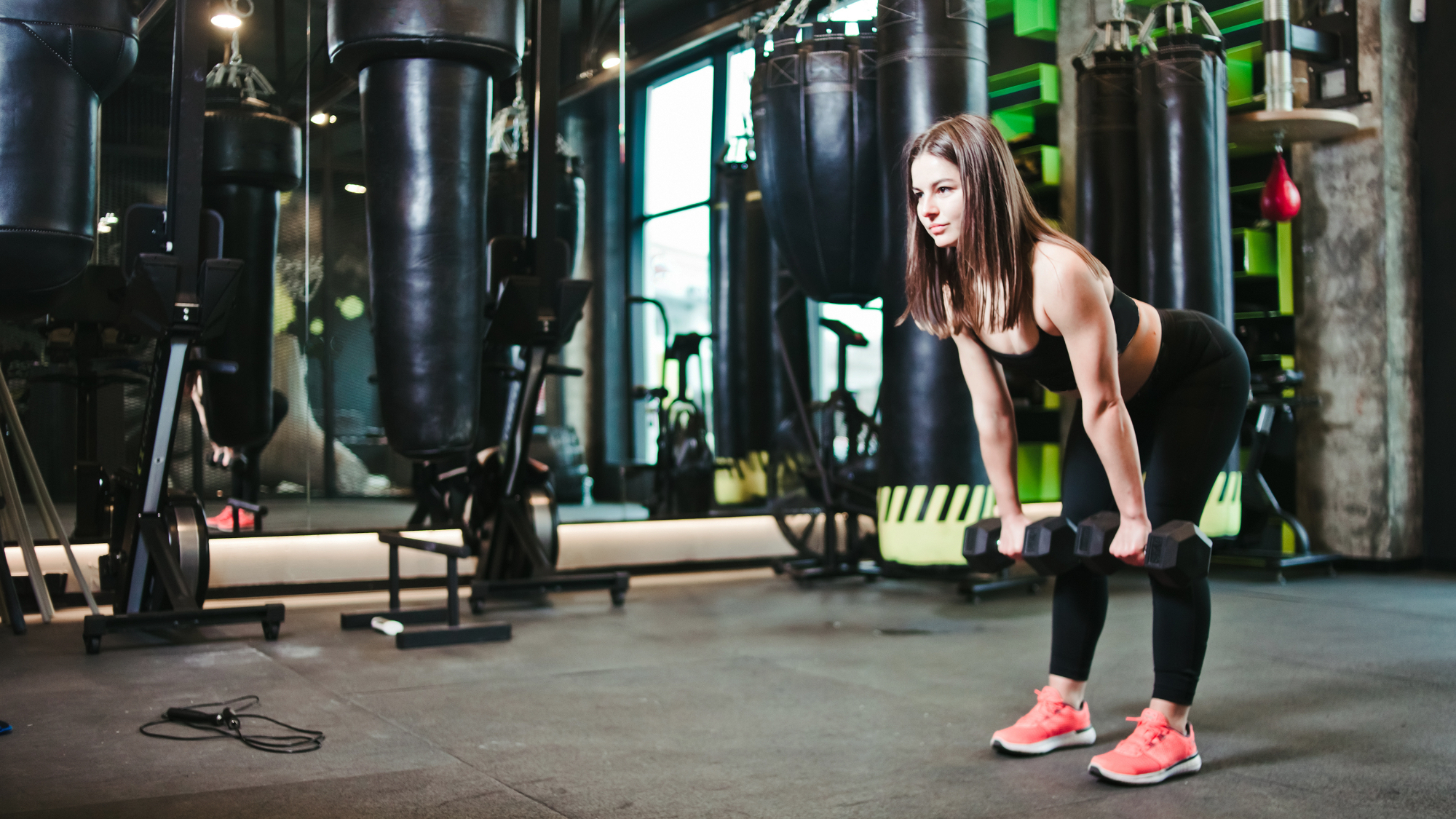
1. Deadlift
- Start with a barbell or pair of dumbbells on the ground in front of you, close to your shins. Bend at the knee and grasp the weight with an overhand grip.
- Push through your feet to straighten your legs, holding the dumbbells in front of you so they’re almost touching your shins and quads on the way up. Keep your spine neutral (straight) throughout the movement.
- Lower the weight back to the ground to complete a rep.
Expert tips:
“This is one of the best strength-boosting, muscle-building exercises you can do," says Horton. "You’re going to be able to move more weight with the deadlift than pretty much any other exercise in the weight room, and by moving weight you’re building muscle.”
Penrose warns this can be a tricky move to perfect, so it's worth learning how to deadlift with dumbbells before starting.
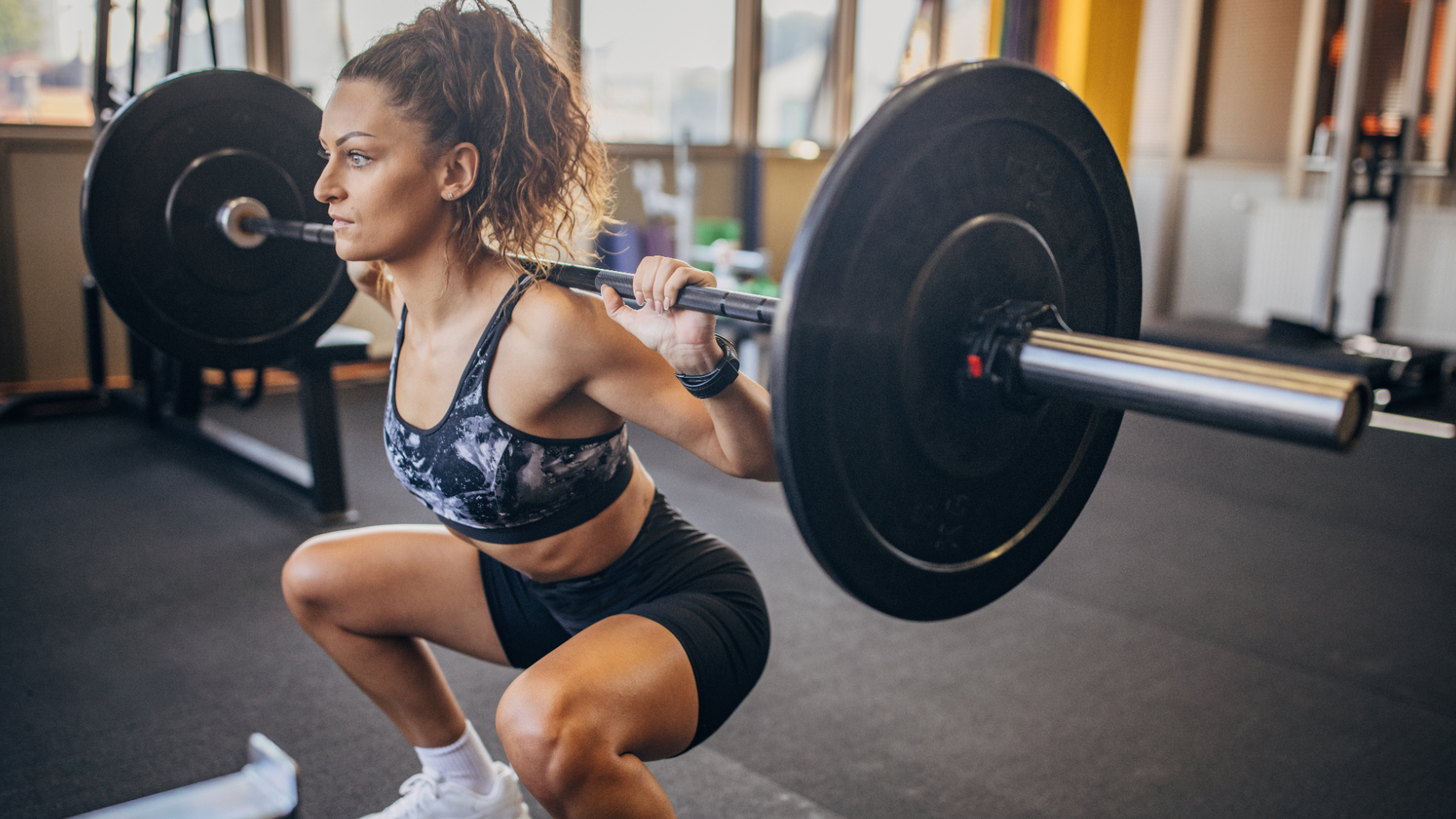
2. Back squat
- Stand with your feet hip-width apart and your chest upright, with a barbell in the back rack position (behind your neck, resting across your shoulders).
- Bend your legs at the knee to lower yourself until your knees are below 90 degrees, keeping your spine straight.
- Straighten your legs to stand back up tall and return to your starting position.
Expert tips
“Technique is key on the back squat,” says Horton. “Along with the deadlift, I think these are the two best exercises to build pure strength. Even though the back squat is a lower body exercise, the back is involved and the core is involved—you’re getting a lot of muscle involved all in one exercise.”
If you don't feel ready to use a barbell, a great way for beginners to add weight to this is to hold a dumbbell or kettlebell in front of you with two hands at chest height, holding it close to the body (this is called a goblet squat).
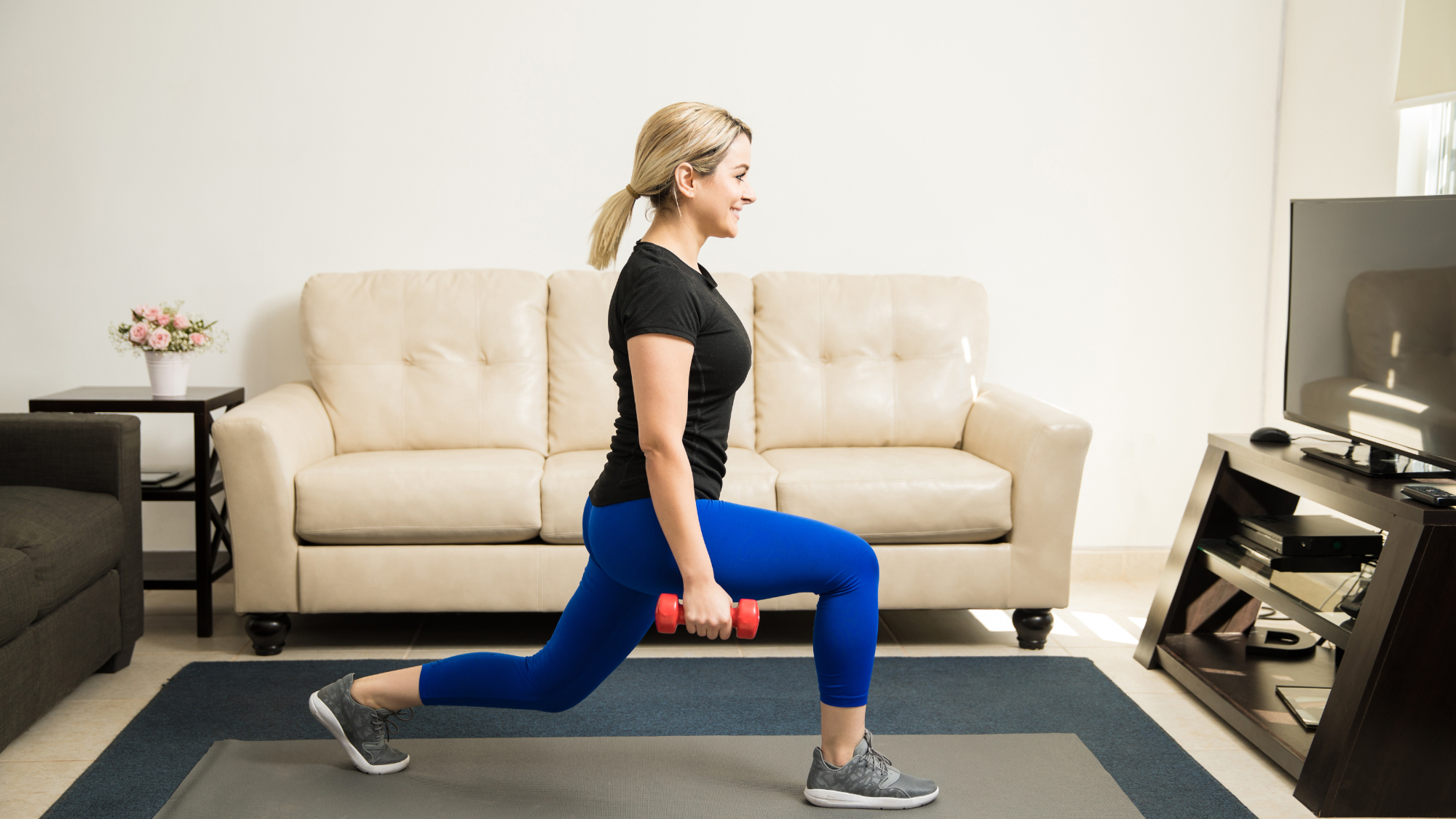
3. Weighted lunge
- Hold a dumbbell in either hand and stand upright with your feet shoulder-width apart.
- Step forward with one leg and lower your back knee towards the floor until both knees are at roughly 90-degrees. The thigh of your lunging leg should be parallel with the ground, while your other thigh should be upright.
- Push hard against the floor with your front foot to return to the starting position, then repeat on the opposite side.

4. Dumbbell thrusters
- Stand upright with a dumbbell in each hand, held at your shoulders.
- Squat down until your thighs are parallel with the ground, then drive through your heels to stand back up tall.
- As you do this, explosively press the dumbbells overhead.
- Lower the dumbbells back to your shoulders as you start your next rep by squatting down again in one fluid movement.
Expert tips:
“This is a great exercise because it’s going to build muscle, burn fat and get the heart rate up at the same time,” says Horton.
“The thruster is also going to incorporate nearly every single muscle in your body, and you can do it at home with dumbbells. Even if you’re just starting with 5lb weights it’s going to be extremely effective, making it more beginner-friendly.”
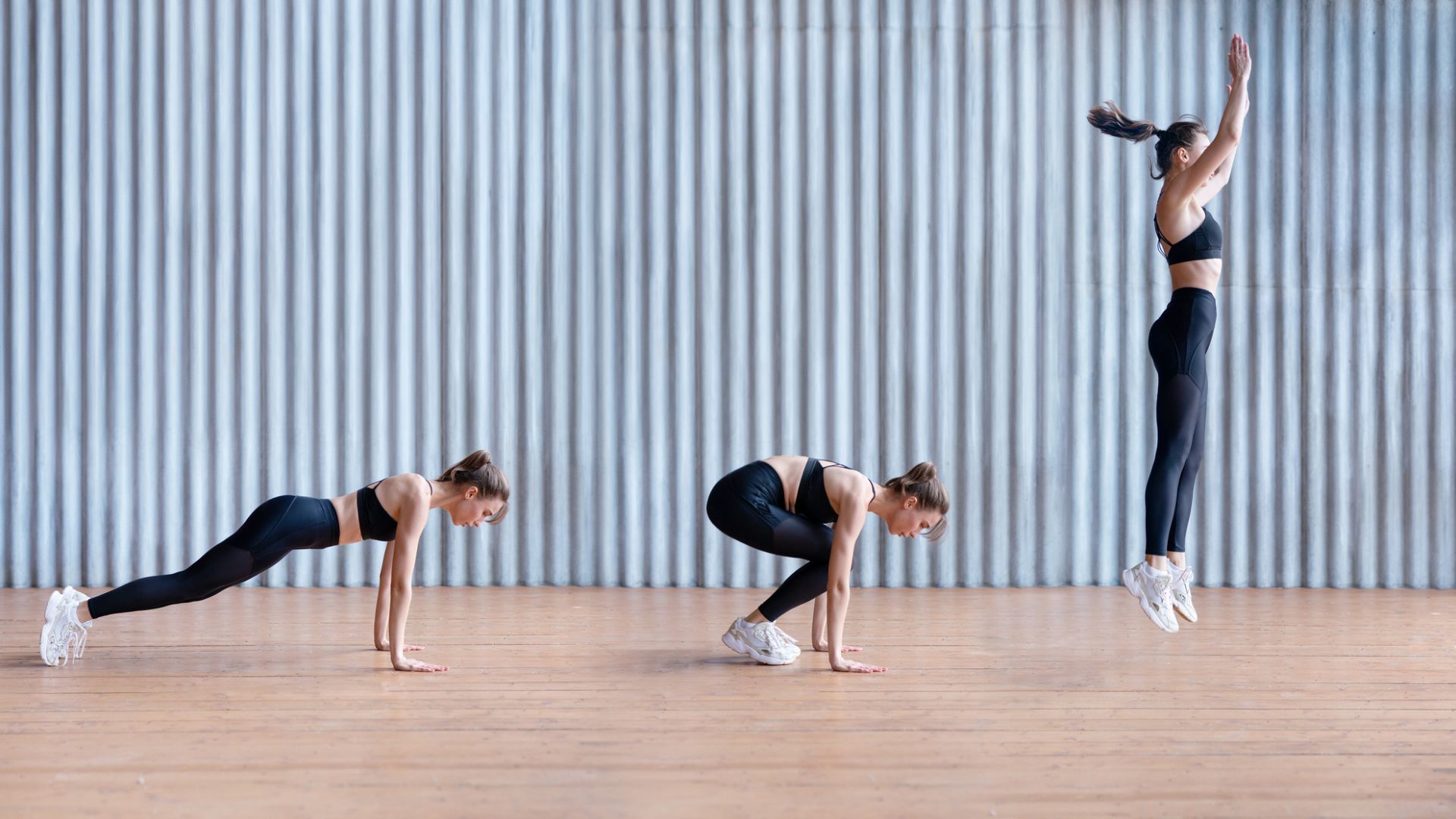
5. Burpees
- Stand upright with your feet roughly hip-width apart.
- Reach your hands down towards the ground in front of you, bending your knees as you plant them on the floor under your shoulders.
- Jump your feet back into a high plank position.
- Lower your chest until you’re lying face-down on the floor.
- Push through your arms to return to a high plank position, then jump or step your feet forward and return to the starting position.
- Jump and clap your hands above your head. That’s one repetition.
Expert tips:
“The burpee is an amazing bodyweight exercise that can build muscle, boost your cardio and burn fat, all at the same time. And, because it’s a bodyweight exercise, you can do it anywhere, any time,” says Horton.
“A set of 10 can get your heart rate pumping in a hurry. That’s why people love them and hate them.”
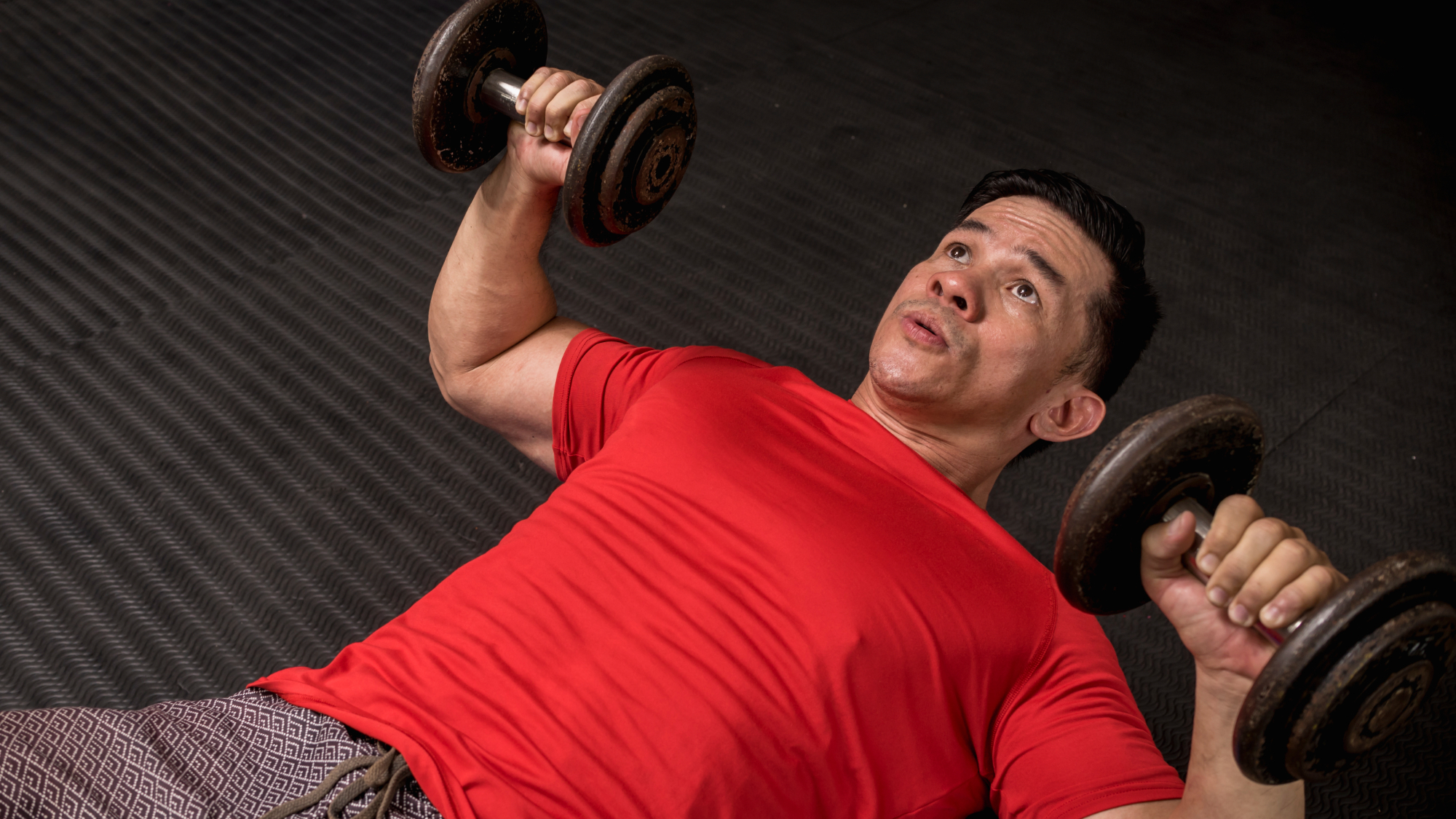
6. Chest press
- Lying flat on the floor (or on a bench if you have one) hold a dumbbell in each hand at chest height either side of your body. Your arms should be bent, with the inner side of the dumbbell close to your torso.
- Press the dumbbells vertically upwards, straightening your arms.
- Pause for a second at the top of the rep, then lower the dumbbells back to the starting position.
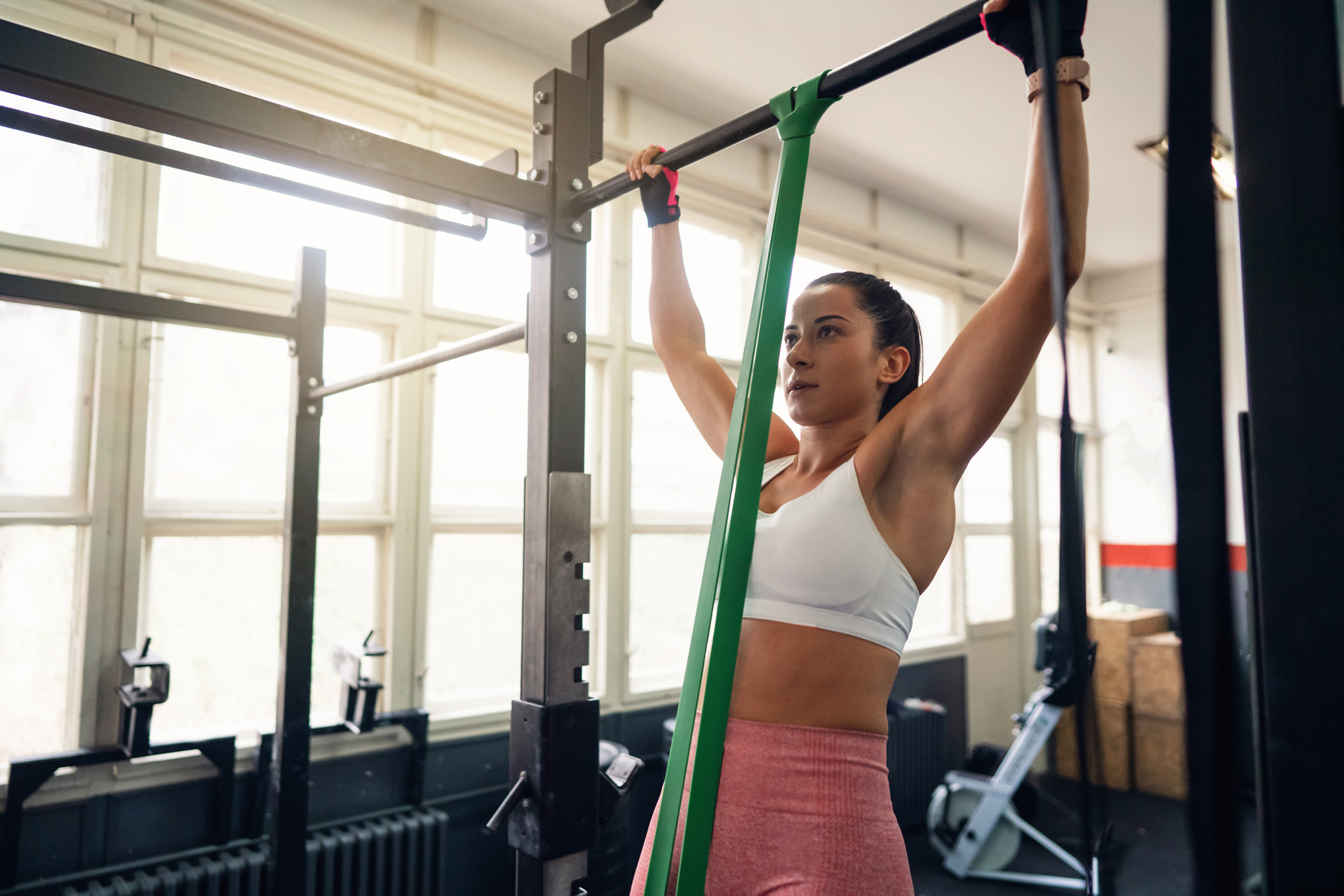
7. Pull-ups
- Grab a pull-up bar with an overhand grip, with your hands slightly wider than shoulder-distance apart.
- Keeping your core tight, hang from the bar and retract your shoulder blades (think about bringing them back and then down, like you’re putting them in the back pockets of a pair of jeans).
- Pull yourself upwards until your chin is above the bar, then control yourself back to the starting position.
Expert tips:
The pull-up is one of the best upper-body strength-building exercises you can do,” proclaims Horton. “The technique is super simple, although the execution can be hard, especially for a beginner. But, if you’re trying to build upper-body strength, it’s one of the simplest and most effective exercises you can do.”
If you’re still learning how to do a pull-up, you can make it easier by using a resistance band, or use exercises like the inverted row or bent-over row (below) to build strength in the back and biceps muscles used in a full pull-up.
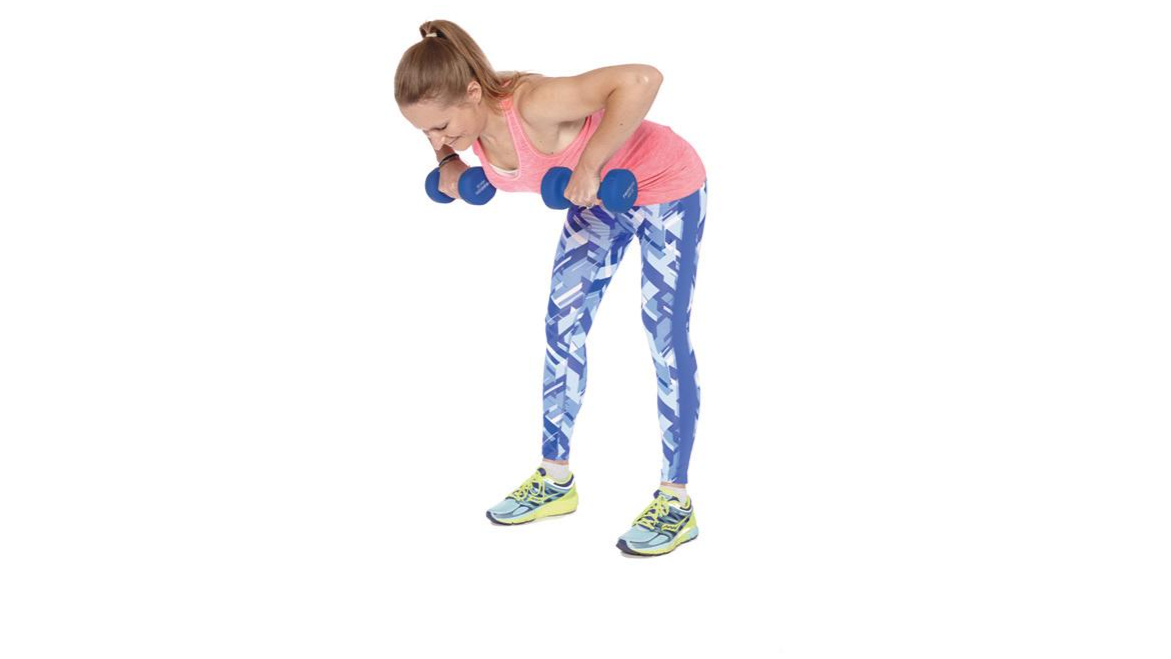
8. Bent-over row
- Hold a dumbbell in each hand.
- Start by standing upright, then hinge at the hip until your torso is almost parallel to the floor. Make sure to keep your core braced and your back straight throughout.
- With your arms straight, allow the weights to hang towards the ground, then retract your shoulder blades.
- Pull the weights towards your belly button, keeping your shoulders back and your elbows tucked into your body, until the dumbbells are level with your stomach.
- Lower them back to the starting position in a controlled fashion, keeping tension in your back throughout.
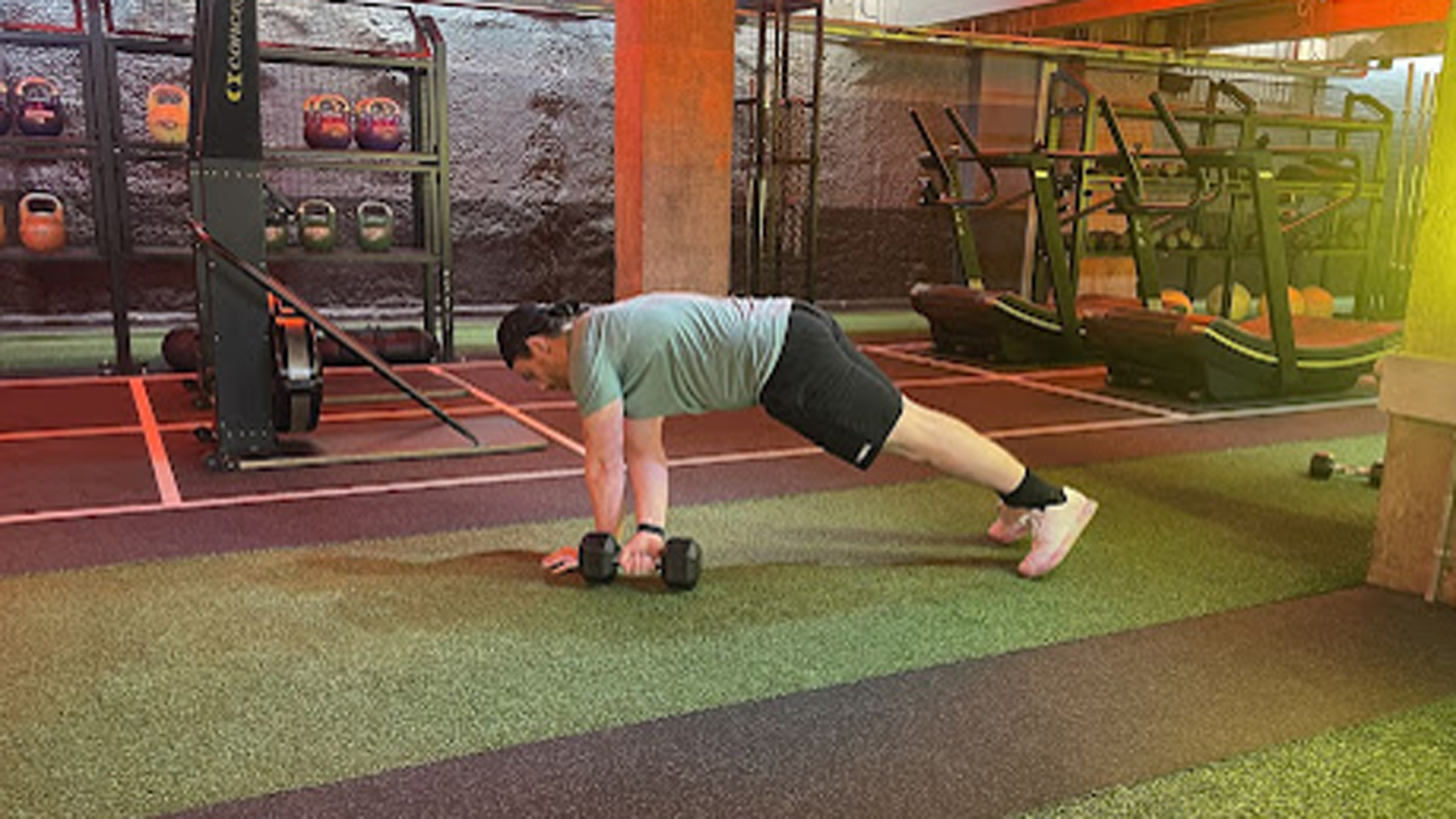
9. Plank dumbbell pull through
- Assume a straight-arm plank position with a dumbbell on one side of your body.
- Reach your opposite arm across your body and pull the dumbbell underneath you,
- Repeat using the other arm to bring the dumbbell back to its original position.
Is strength training good for losing weight?
The short answer to this question is yes, strength training can aid weight loss in many people if balanced with the right diet—a sustainable calorie deficit, plenty of protein to support muscle recovery and growth, and nutritious foods to fuel you through the day.
Building your muscle mass can also boost your metabolism.
“A pound of muscle, depending on the research, is going to burn seven to 10 calories per day,” Horton tells me.
“If you think of it in those terms and do a little math, so let’s just say 10 to make the math easy, if I can add a pound of muscle then that pound of muscle is going to burn 10 calories a day. That’s 300 calories a month, and that’s roughly 3,600 calories for the year.”
As a metabolically active tissue, the more muscle you have, the more calories you will burn at rest, helping you achieve a calorie deficit.
Effective strength training can also keep your joints healthy, improve your mobility and boost your bone density, helping you build a fit and functional body that can handle everyday activities with ease.
How to perform strength training exercises for weight loss
Penrose defines strength training as “increasing muscular strength by making muscles work against a force”.
“This can be done by lifting weights, but can also be achieved through bodyweight movements and performing isometric and plyometric movements [for example, the plank or explosive exercises like box jumps],” she explains.
She prescribes a thorough warm-up before any strength training, targeting the muscles you are going to be using, and also stresses the importance of perfecting your technique before adding too much weight to any exercise.
Once you've learned how to perform exercises like the squat and deadlift with light weight and correct form, you can begin increasing the resistance, upping the intensity of your workout to take advantage of the strength-building progressive overload principle.
Which type of strength training is best for fat loss?
Exercise, by definition, involves completing structured activity that raises your heart rate (burning calories as a result). But training for fat loss doesn’t need to center around a stereotypical sweaty run or grueling HIIT circuit.
“Putting your body under stress by lifting weights requires more oxygen to be pumped through your body to your muscles,” says Penrose. “This instantly raises your heart rate, which in turn burns calories.”
This can help you achieve a calorie deficit, although Penrose emphasizes the importance of not creating an excessive deficit as this may leave you lacking the energy and resources your body requires to function effectively. Or, in other words: “You need sustenance and fuel to perform not only daily tasks, but also to train.”
Strength training vs cardio vs HIIT
You don’t need to fall fully into any camp—variety is the spice of life, after all. Instead, Horton recommends a blend of training styles (aka, cross training) depending on your goals and what you enjoy most.
“Strength training is super important because of the long-term weight management benefits. It’s also important from a health standpoint.
“It’s going to make your body healthier, from a movement standpoint, building bone density and making your day-to-day activities feel easier—if you’re picking up grandkids or carrying your groceries, that’s going to feel much less taxing.”
He says cardiovascular activities like walking, running, cycling and HIIT are also important for your heart health, so it’s good to find a balance between the training styles.
“I don’t think you should go out and run three times a week and not do any strength training; I also don’t think you should be going to the gym three times a week and doing absolutely no cardio.
“For me, it’s 60:40 to the strength training side, but a couple of friends of mine love running. They may be 70:30 to the running side, because that’s the thing they’re going to really enjoy.
“So for them it’s like ‘OK, two days a week let’s get in the gym, grab some dumbbells and move some weight’, which is going to help with their joint health and bone density—both really important for runners.
“That ratio can go either way, I just think you need to get a little bit of both.”

Harry Bullmore is a Fitness Writer for Fit&Well and its sister site Coach, covering accessible home workouts, strength training session, and yoga routines. He joined the team from Hearst, where he reviewed products for Men's Health, Women's Health, and Runner's World. He is passionate about the physical and mental benefits of exercise, and splits his time between weightlifting, CrossFit, and gymnastics, which he does to build strength, boost his wellbeing, and have fun.
Harry is a NCTJ-qualified journalist, and has written for Vice, Learning Disability Today, and The Argus, where he was a crime, politics, and sports reporter for several UK regional and national newspapers.